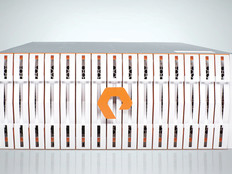Greening the Network
At the University of Nebraska, the information services group is embarking on a network refresh project that could significantly boost energy efficiency. The university will upgrade the wired and wireless networks in 17 residence halls that house about 6,000 students.
“We have been researching equipment, and power usage has been paramount in our decision-making process,” says Michael Ruhrdanz, director of IS communications and operations at the University of Nebraska in Lincoln.
Gearing Up
Ruhrdanz explains that by focusing on energy-efficient hardware, the university will win on more than one count. “Most of the networking equipment goes into small wiring closets, so we have to contend not only with power usage but also with heat generated,” he says. “If we install equipment that uses less power, it emits less heat and requires less infrastructure improvements to cool.”
UPS systems will power the equipment during power failures — not a small issue, the director adds, considering that more building security systems rely on the network now than in the past.
Once the residence hall networks are upgraded, the next step will be to upgrade the network in nearly 200 University of Nebraska buildings. “We expect to use the lessons we learn from the residence hall project to create energy savings throughout campus,” Ruhrdanz says.
Many colleges are working toward a greener network, says Eric Woods, a research director at Pike Research. “Traditionally, the network has been a relatively small piece of the effort to increase energy efficiency in the data center,” he says. “But as we virtualize networks, servers and storage — creating more complex data traffic and dependencies — the network becomes a bottleneck in terms of performance and energy consumption. Considering the networking aspects of energy efficiency will become increasingly important.”
At Kingsborough Community College in New York, the IT department has invested roughly $1 million over the past six years to replace nearly all of its switches and routers with energy-efficient Summit switches from Extreme Networks. The IT team is also spearheading a major project to take the entire Brooklyn campus wireless using gear from Meru Networks.
31%
Percentage of organizations that have implemented power-efficient networking equipment
SOURCE: "Energy Efficient IT Report" (CDW•G, April 2012)
The wireless rollout is slated for completion in September. “With a wireless campus, we won’t need additional switches to take care of increasing enrollment and extension of resources to mobile devices, so we won’t have to deal with the heat that switches generate,” says CIO Asif Hussain.
Conscious Consumption
To get the most out of green infrastructure initiatives, it’s important to understand exactly how the network and the components and processes it supports are operating. “These tools, which are still evolving, help clarify where the energy is being used and where the hot spots are,” says Woods. That information can shed light on which network switches and other gear are most worthy of replacement.
To learn more about boosting energy efficiency, consult CDW•G’s Energy Efficient IT Report.
Higher Education Advances the Green IT Movement
All around the country, colleges and universities are taking the concept of green seriously — both in technology and on campus generally. Most have far-reaching initiatives and policies for “going green,” including construction of green buildings.
The IS department at the University of Nebraska has its own set of green initiatives, pledging to consider energy and environmental efficiency when considering any potential upgrade or improvement.
In the data center, the initiative has produced big results. All of the heat currently generated in the data center during winter months is recycled back into the building, and the energy savings allows the IT department to cool the data center during the summer months at no cost. The data center also takes advantage of hot- and cold-aisle containment, server virtualization and a new UPS system that runs at 99 percent efficiency.
New York’s Kingsborough Community College in Brooklyn is also passionate about green. Starting with an initiative around 2006 to put green concerns first, the IT department has taken great strides since then. Not only has it virtualized its entire data center, but it has moved libraries and classrooms away from CRT terminals to thin clients.
“Every time we replace equipment, we ask vendors questions about energy efficiency and how they plan to dispose of the equipment,” says CIO Asif Hussain. “We’re always thinking green.”








